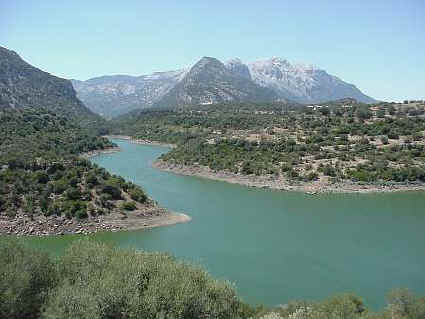 |
 |
 |
 |
This odd-looking map shows the pattern of winds we saw most often in Corsica, the candle-shaped island in blue, and Sardinia, shown in green. Both of these islands are west of Italy's boot, shown in red, as is Sicily, just off the "toe". The direction of each arrow shows the origination of the wind, and the length of the arrow depicts its strength. The strong mistral comes down from the Gulf of Lyon at France's coast and wraps itself around both islands and works its way around the east side as well. The mistral is quite strong on the west side, but shielded on the east side by the land, as you can see from the short arrows. We fought strong winds all the way down Corsica's beautiful west coast, but we succumbed to the gentler weather and decided to come down the east side for our Sardinian travels. |
|
This confluence of two rivers is a typical inland scene in Sardinia. While the mountains are not as high as those in Corsica, the combination of craggy peaks and scrub vegetation gives much of the island an empty, majestic look. |
 |
|
We knew that flamingoes come to Sardinia to nest in the winter, but we did not realize that the winter season included August. On a trip to look at Capo Comino beach, where the movie Swept Away was filmed, we happened upon dozens of flamingoes in a salt flat near the beach, spending most of their time with their heads in the muck. |
|
|
We took the Trenino Verde (little green train) into the Montarbu Forest. The railroad bridge you see at right is an Eiffel Tower-era bit of development in the middle of nowhere, and we walked across it to get to the forest. There is a large, rocky gorge underneath the bridge that we tried not to look at through the open grates of the tracks. Along the route, the train wends its way back and forth across the mountains. An hour into the trip, you can still see the area you left, far below, and the tracks you just traveled. We also saw sughero, cork trees, that had been stripped of their bark and left to regenerate in another decade's time. |
|
|
At left, you can see Santa Maria Navarrese harbor. The water is clear and green. Like this one, many of Sardinia's marinas are new or newly enlarged and redeveloped, and most of the harbors are artificial, with stone or concrete breakwaters. Note the gentle slope of the Sardinian mountains in the distance. |